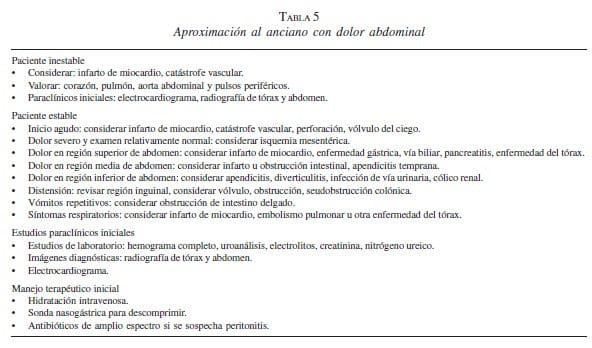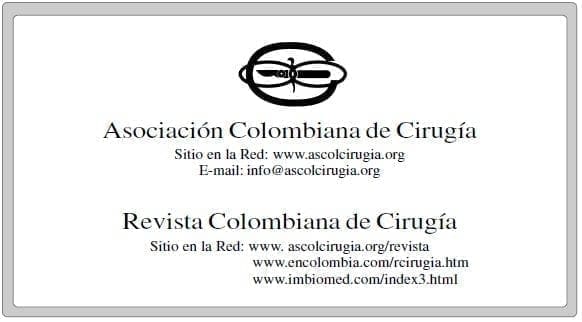El tratamiento del abdomen agudo en el anciano se convierte en un reto para el médico debido a las características particulares en este tipo de pacientes: su manifestación insidiosa, escasos síntomas y signos, y los datos poco específicos obtenidos a través de los paraclínicos básicos (hemograma, bioquímica y radiografías simples de abdomen) (27).
En cuanto a la valoración por un cirujano, ésta depende de la impresión diagnóstica y de la estabilidad clínica del paciente; los pacientes inestables con sospecha de emergencia quirúrgica intraabdominal como peritonitis difusa, isquemia mesentérica, ruptura de AAA, perforación de víscera, hernia incarcerada y vólvulo requieren valoración urgente por cirugía.
Por el contrario, en los pacientes estables con enfermedad menos severa, se puede diferir dicha valoración posterior a la realización de los diferentes examenes paraclínicos básicos; sin embargo, por las dificultades diagnósticas y terapéuticas presentes en los pacientes ancianos con dolor abdominal, la evaluación temprana realizada por el cirujano es un elemento clave para el manejo de estos pacientes.
El tratamiento inicial que se debe seguir en un anciano con dolor abdominal agudo incluye: control de signos vitales, oximetría de pulso, monitoría electrocardiográfica, acceso intravenoso y oxígeno con base en su condición clínica.
Al mismo tiempo, en la mayoría de los casos se debe suspender la vía oral y no utilizar analgésicos dado que pueden enmascarar aún más el cuadro clínico, puesto que de por sí los cambios con el envejecimiento, la comorbilidad y los medicamentos son factores que dificultan la realización de un diagnóstico precoz y una conducta terapéutica adecuada (69).
En cuanto al uso de antibióticos éstos se encuentran indicados en diferentes patologías de origen intraabdominal, entre otras: la apendicitis, colecistitis, diverticulitis, perforación de víscera y pancreatitis severa con el propósito de cubrir no sólo patógenos gramnegativos sino también anaerobios.
Se utilizan cefalosporinas de segunda generación para pacientes que no están tóxicos mientras que aquellos severamente enfermos requieren de un cubrimiento de amplio espectro con una cefalosporina de tercera o cuarta generación más metronidazol (tabla 5) (36).

Se considera que aproximadamente un tercio de los ancianos que consultan por dolor abdominal agudo van a requerir un procedimiento quirúrgico de urgencia; por lo tanto, su evaluación durante el período preoperatorio es necesario que sea realizada por un equipo interdisciplinario, en el que estén presentes geriatras, cirujanos y anestesiólogos con el objetivo de optimizar el funcionamiento cardiovascular y pulmonar, de modo que se pueda garantizar una intervención quirúrgica y un período posoperatorio acorde con las necesidades de cada paciente. Así se podrían mejorar los resultados con disminución de las complicaciones y de la mortalidad (22). ¡
Conclusión
El diagnóstico de la etiología del dolor abdominal agudo en pacientes ancianos puede ser una tarea complicada para el médico debido a la ausencia relativa de síntomas y signos físicos, lo cual hace que su presentación en muchos de los casos sea atípica.
Por consiguiente, al momento de la valoración se debe clasificar dentro de los cuatro grupos posibles: inflamatorio, obstructivo, vascular o sistémico. En cuanto a la realización de estudios paraclínicos, la ecografía o TAC abdominal es la prueba de gran importancia durante el diagnóstico. La valoración temprana por un cirujano se convierte en un elemento importante tanto para el diagnóstico como para el tratamiento.
Acute abdomen in the Elderly
Abstract
With the continued population growth it is expected that greater numbers of patients will be consulting because of acute abdominal clinical conditions requiring integral and timely care.
The elderly patient usually seeks medical care in advanced stages of disease and presents with coexistent morbidities that may adversely affect the course of the primary illness.
Therefore, the correct diagnosis of abdominal pain becomes a real challenge to the physician, facing a person that generally presents absence of classical symptoms and signs, making the clinical presentation atypical. A significantly high number of these patients require an emergency operation with the corresponding adverse implications. The death of elderly patients presenting with acute abdomen frequently is due to delayed diagnosis, surgical intervention and the attending infectious complications that may lead to generalized sepsis, cardiac and pulmonary complications that exacerbate the comorbidities, conditions that are poorly tolerated by the person of advanced age. Thus the obligation of timely prevention, diagnosis and treatment in the elderly population.
Key words: acute abdomen, aging, aged, emergencies, abdominal pain.
Referencias
1. Organización Panamericana de la Salud. Salud de las personas de edad. Envejecimiento y salud: un cambio de paradigma. Washington: OPS 1998; CSP25/12.
2. Departamento Administrativo Nacional de Estadística (DANE). Colombia: proyecciones quinquenales de población por sexo y edad 1950-2050. Bogotá: DANE 1998.
3. BAUM SA, RUBENSTEIN LZ. Old people in the emergency room: age related differences in the emergency department use and care. J Am Geriatr Soc 1987; 35: 398-404.
4. BUGLIOSI TF. Acute abdominal pain in the elderly. Ann Emerg Med 1990; 19: 1383-1386.
5. JIN F, CHUNG F. Minimizing perioperative adverse events in the elderly. Br J Anaesth 2001; 87: 608-624.
6. ESPINOZA R, LÓPEZ F, GUZMÁN S, ARROYO C, IBÁÑEZ L, GUZMÁN S, et al. Patología biliar litiásica en mayores de 75 años. Rev Chil Cir 1997; 49: 153-156.
7. POWERS RD, GUERTLER AT. Abdominal pain in the ED: stability and change over 20 years. Am J Emerg Med 1995; 13: 301-303.
8. VALDÉS JM, MEDEROS ON, BARRERA JC, CANTERO A, PEDROSO Y. Abdomen agudo quirúrgico en el anciano. Rev Cubana Cir 2002; 41: 23-27.
9. ESCARCE JJ, SHEA JA, CHEN W. Outcomes of open cholecystectomy in the elderly: a longitudinal analysis of 21,000 cases in the prelaparoscopic era. Surgery 1995; 117: 156-164.
10. CALLAHAN EH, THOMAS DC, GOLDHIRSCH SL, LEIPZIG RM. Geriatric hospital medicine. Med Clin North Am 2002; 86: 707-729.
11. NISHIDA K, OKINAGA K, MIYAZAWA Y, SUZUKI K, TANAKA M, HATANO M, et al. Emergency abdominal surgery in patients aged 80 years and older. Surg Today 2000; 30: 22-27.
12. STRANGE GR, CHEN EH, SANDERS AB. Use of emergency departments by elderly patients: projections from a multicenter data base. Ann Emerg Med 1992; 21: 819-824.
13. BREWER BJ, GOLDEN GT, HITCH DC, RUDOLF LE, WANGENSTEEN SL. Abdominal pain. An analysis of 1,000 consecutive cases in a university hospital emergency room. Am J Surg 1976; 131: 219-223.
14. MIETTINEN P, PASANEN P, SALONEN A, LATINEEN J, ALHAVA. The outcome of elderly patients after operation for acute abdomen. Ann Chir Gynaecol 1996; 85: 11-15.
15. DOMBAL FT. Acute abdominal pain in the elderly. J Clin Gastroenterol 1994; 19: 331-335.
16. MUIÑO MIGUEZ A, RODRÍGUEZ DE CASTRO E, GONZÁLEZ RAMALLO VJ, LÁZARO BERMEJO C, HERGUETA MARTÍN-ARTAJO L. Dolor abdominal en el servicio de urgencias. Seguimiento de pacientes con dolor no filiado. An Med Interna (Madrid) 1989; 6: 23-25.
17. IRVIN TT. Surgical audit of the acute abdomen. Br J Surg 1989; 76: 1121-1125.
18. BENDER JS. Cuadro abdominal agudo. Med Clin North Am 1989; 6: 1549-1558.
19. FENYO G. Acute abdominal disease in the elderly: Experience from two series in Stockholm. Am J Surg 1982; 143: 751-754.
20. PARRA GS, MARULANDA F, SANTACOLOMA M, OSORIO M, CHACÓN JA. Dolor abdominal agudo en el anciano en el Hospital de Caldas. Rev Colomb Gastroenterol 2003; 18: 146-152.
21. ESPINOZA R, BALBONTÍN P, FEUERHAKE S, PIÑERA C. Abdomen agudo en el adulto mayor. Rev Méd Chile 2004; 132: 1505-1512.
22. KIZER KW, VASSAR MJ. Emergency department diagnosis of abdominal disorders in the elderly. Am J Emerg Med 1998; 16: 357-362.
23. VOGT DP. The acute abdomen in the geriatric patient. Cleve Clin J Med 1990; 57: 125-130.
24. DUNNE ML, STRAUSS RW. Approach to the elderly patient. In: Judd RL, Warner CG, Shaffer MA (eds). Geriatric Emergencies. Aspen Publishers 1986: 1-10.
25. CASTLE SC, NORMAN DC, YEH M, MILLER D, YOSHIKAWA TT. Fever response in elderly nursing home residents: are the older truly colder? J Am Geriatr Soc 1991; 39: 853-857.
26. CERVERO F, LAIRD J. Visceral pain. Lancet 1999; 353: 2145-2148.
27. GÓMEZ M, ZAERA A, VIÑA V, PASCUAL T, MARCO A. Dolor abdominal agudo en el anciano. An Med Interna (Madrid) 2001; 18: 168-170.
28. AHN SH. Acute nontraumatic abdominal pain in adult patients: abdominal radiography compared with CT evaluation. Radiology 2002; 160: 159-164.
29. LEE JF, LEOW CK, LAU WY. Appendicitis in the elderly. Aust N Z J Surg 2000; 70: 593-596.
30. FLEISHER LA, PASTERNAK LR, HERBERT R, ANDERSON GF. Impatient hospital admision and death after out patient surgery in elderly patient. Arch Surg 2002; 139: 67-72.
31. HORATTAS MC. A reappraisal of appendicitis in the elderly. Am J Surg 1990; 160: 291.
32. VORHES CE. Appendicitis in the elderly. The case for better diagnosis. Geriatrics 1987; 42: 89-92.
33. MORALES RA, ORDINALS J, SALCEDO L, LADAHA N, FERNÁNDEZ S. Morbilidad y mortalidad de la apendicitis aguda en los pacientes geriátricos 1990-1999. Rev Cubana Cir 2002; 41: 28-32.
34. STORM-DICKENSON TL, HORATTAS MC. What have learned over the past 20 tears about appendicitis in the elderly? Am J Surg 2003; 185: 198-201.
35. Reid G. Asymptomatic bacteriuria in spinal cord patients and the elderly. Urol Clin North Am 1999; 26: 789-795.
36. HENDRICKSON M, NAPARST TR. Abdominal surgical emergencies in the elderly. Emerg Med Clin North Am 2003; 21: 937-969.
37. MEZEY E. Diseases of the gallbladder and biliary tree. In: Hazard WR, Blass JP, Ettinger, Jr. WH, Halter JB, Ouslander JGH, eds. Principles of Geriatric Medicine and Gerontology. 4th New York: McGraw-Hill; 1999; 873-875.
38. CERVANTES J. Coledocolitiasis: evolución del diagnóstico y tratamiento. Rev Colomb Cir 2002; 17: 49-56.
39. ADEDEJI OA. Murphy’s sign, acute cholecystitis and elderly people. J R Coll Surg Edinb 1996; 41: 88-89.
40. BEJARANO M. Exactitud diagnóstica de la ecografía en patología vesicular. Rev Colomb Cir 2002; 17: 207-212.
41. HENDERSON SO, SWADRON SP, NEWTON E. Ketorolac in biliary colic: a randomized, double blinded comparison with meperidine. J Emerg Med 2002; 23: 237-241.
42. TELFER S, FENYO G, HOLT PR, DE DOMBAL FT. Acute abdominal pain in patients over 50 years of age. Scand J Gastroenterol Suppl 1988; 144: 47-50.
43. PAINTER NS, BURKITT DP. Diverticular disease of the colon: a deficiency disease of Western civilization. BMJ 1971; 2: 450- 454.
44. MANOUSOS ON, TRUELOVE SC, LUMSDEN K. Prevalence of colonic diverticulosis in general population of Oxford area. BMJ 1967; 3: 762-763.
45. KANG JY, MELVILLE D, MAXWELL JD. Epidemiology and management of diverticular disease of the colon. Drugs Aging 2004; 21: 211-228.
46. WONG WD, WEXNER SD, LOWRY A. Practice parameters for the treatment of sigmoid diverticulitis-supporting documentation. Dis Colon Rectum 2000; 43: 290-297.
47. CHO KC, MOREHOUSE HT, ALTERMAN DD. Sigmoid diverticulitis: diagnostic role of CT-comparison with barium enema studies. Radiology 1990; 176: 111-115.
48. AYDIN HN, REMZI FH. Diverticulitis: when and how operate. Dig Liver Dis 2004; 36: 435-445.
49. HIGHAM J, KANG JY, MAJEED A. Recent trends in admissions and mortality due to peptic ulcer in England: increasing frequency of haemorrhage among older subjects. Gut 2002; 50: 460-464.
50. JERZY JANIK, PIOTR CHWIROT. Perforated peptic ulcer-time trenes and patterns over 20 years. Med Sci Monit 2000; 6: 369-372.
51. CHOU NH, MOK HT, CHONG HT, LEU SI, TSAI C, WONG W. Risk factors of mortality in perforated peptic ulcer. Eur J Surg 2001; 66: 149-153.
52. GLOOR B. Pancreatic disease in the elderly. Best Pract Res Clin Gastroenterol 2002; 16: 159-170.
53. MCKAY CJ. High early mortality rate from AP in Scotland, 1984- 1995. Br J Surg 1999; 86: 1302-1305.
54. BLOMGREN LG. Perforated peptic ulcer: long-term results after simple closure in the elderly. World J Surg 1997; 21: 412-414.
55. WINEK TG. Pneumoperitoneum and its association with ruptured abdominal viscus. Arch Surg 1988; 123: 709-712.
56. CHEN CH. Role of upright chest radiography and ultrasonography in demonstrating free air of perforated peptic ulcers. Hepatogastroenterology 2001; 48: 1082-1084.
57. DE DOMBAL FT. Acute abdominal pain in the elderly. J Clin Gastroenterol 1994; 19: 331-335.
58. KAUVAR DR. The geriatric abdomen. Clin Geriatr Med 1993; 9: 547.
59. AHN SH, MAYO-SMITH WW, MURPHY BL, REINERT BE, CRONAN JJ. Acute nontraumatic abdominal pain in adult patient: abdominal radiography compared with CT evaluation. Radiology 2002; 225: 159-164.
60. SFAIRI A. Acute appendicitis in patients over 70 years of age. Presse Med 1996; 25: 707-710.
61. BRANDT LJ, BOLEY SJ. AGA technical review on intestinal ischemia. Gastroenterology 2000; 118: 954.
62. DIAMOND S, EMMETT M, HENRICH WL. Bowel infarction as a cause of death in dialysis patients. JAMA 1986; 256: 2545–2547.
63. BICKERSTAFF LK, HOLLIER LH, VAN PEENEN HJ, MELTON LJ, PAIROLERO PC, CHERRY KJ. Abdominal aortic aneurysms: the changing natural history. J Vasc Surg 1984; 1: 6-12.
64. GONZÁLEZ A, PESTANA RA, MARZAN AJ, VENGOECHEA AF. Cirugía del aneurisma de la aorta abdominal. Bases fisiológicas y monitoría. Rev Colomb Cir 1999; 14: 152-163.
65. Gastrointestinal disorders. In: Beers MH, Berkow R (eds.). The Merck manual of geriatrics. Whitehouse Station, NJ: Merck Research Laboratories, 2000; 1000-1052.
66. ROHRER MJ, CUTLER BS, WHEELER HB. Long-term survival and quality of life following ruptured abdominal aortic aneurysm. Arch Surg 1988; 123: 1213-1217.
67. SAKALIHASAN N, LIMET R, DEFAWE OD. Abdominal aortic aneurysm. Lancet 2005; 365: 1577-1589.
68. KAMIN RA, NOWICKI TA, COURTNEY DS, POWERS RD. Pearls and pitfalls in the emergency department evaluation of abdominal pain. Emerg Med Clin North Am 2003; 21: 61-72.
69. DANG C, AGUILERA P, DANG A, SALEM L. Acute abdominal pain: four classifications can guide assessment and management. Geriatrics 2002; 57: 30-42.



